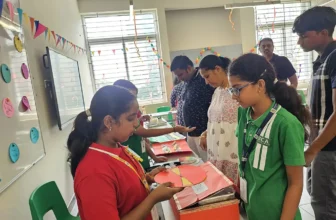
Alright, buckle up, folks! We’re diving headfirst into the bonkers world where beakers meet butter, and Bunsen burners hang out with BBQ grills. Imagine, if you will, a realm where Bill Nye and Guy Fieri throw a rager, mixing chemistry with culinary arts to teach us that learning science can be as tasty as it is thrilling.
First, let’s get the intro out of the way like the obligatory TikTok dance move we all cringe at but secretly practice in our bedrooms. Science and culinary arts—sounds like two awkward teens at a high school dance, right? Wrong! This duo is hotter than the latest viral meme. It’s like the Avengers of education, with the combined powers of sensory overload and brainy brilliance.
Let’s hit the rewind button and travel back to the past, where cavemen invented fire and presumably the first burnt toast. Fast forward a few millennia, and we have the Ancient Egyptians making beer with the same care you’d reserve for your latest Netflix binge. Their brewing techniques? All based on scientific principles that were as groundbreaking then as a Kardashian Instagram post is now. These ancient food scientists were the OGs of kitchen chemistry, laying the groundwork for the culinary wonders to come.
Enter the Middle Ages, where alchemists, who were basically medieval mad scientists, tried turning base metals into gold but accidentally discovered distillation. This booze-fueled era gave birth to spirits, not the spooky kind, but the kind that makes your uncle dance on tables at weddings. Science and culinary arts were already mingling like peanut butter and jelly, setting the stage for future gastronomic genius.
Now, let’s catapult ourselves to the modern era, where things get more exciting than the latest Marvel movie. Molecular gastronomy—sounds fancy, right? It’s just a bougie way of saying we’re using science to make food do weird and wonderful things. Think foams, gels, and edible spheres that explode in your mouth like a flavor grenade. Chefs like Ferran Adrià and Heston Blumenthal are the Tony Starks of the kitchen, engineering dishes that make your taste buds do a happy dance.
But wait, there’s more! Imagine a project where kids learn science through the lens of cooking. Introducing “The Science of Cooking” workshops, where young minds whip up knowledge while whipping cream. Picture this: a classroom that’s part chemistry lab, part “Chopped” episode, where students don lab coats and chef hats, ready to explore the delicious world of edible experiments. Here, baking soda and vinegar aren’t just for volcano projects—they’re key ingredients in a culinary education revolution.
Take, for example, a workshop where kids create molecular gastronomy masterpieces. They learn about emulsions by making mayo, study protein denaturation through perfecting the poached egg, and even delve into the wonders of fermentation with homemade pickles. It’s like “Breaking Bad,” but with less meth and more method to the madness. These workshops are the culinary equivalent of a Marvel training montage, turning everyday ingredients into heroes of the kitchen.
Now, let’s talk benefits, shall we? Learning science through culinary arts is like hitting the jackpot in an educational casino. First, there’s the sensory explosion—think of it as a multi-sensory assault, like watching a 3D movie while riding a rollercoaster and eating popcorn. Cooking engages sight, smell, touch, and taste, making science not just a subject to be learned but an experience to be savored. Plus, the cognitive benefits are off the charts. When kids measure ingredients, they’re doing math. When they follow a recipe, they’re honing their reading and comprehension skills. And when they experiment with flavors, they’re exercising creativity and critical thinking.
But the magic doesn’t stop there. Learning science through cooking fosters teamwork and communication, as students collaborate on recipes and share their delicious successes (or hilarious failures). It’s a culinary classroom where mistakes are just happy accidents that might lead to the next great food invention—kind of like how the internet discovered that pineapple on pizza isn’t entirely sacrilegious.
So, let’s bring this culinary carnival to a close with a final sprinkle of wisdom. The potential of culinary arts in science education is like discovering a cheat code in a video game—it opens up a whole new world of possibilities. By incorporating cooking into the curriculum, we make learning science as irresistible as a perfectly baked chocolate chip cookie. Imagine schools with kitchens as well-equipped as their labs, where students experiment with edible science every day.
In conclusion, the fusion of science and culinary arts isn’t just a flash in the pan—it’s a full-blown educational revolution. From ancient brewers to modern molecular gastronomists, and from medieval alchemists to today’s kitchen scientists, this dynamic duo has proven that the way to the brain is through the stomach. So, let’s roll up our sleeves, preheat the oven, and cook up some chaos in the name of learning science. Bon appétit, nerds!








1Win online oyunlarda qazanmaq şansını artırır | 1Win login vasitəsilə hesabınıza asanlıqla daxil olun | 1Win oyunçularına qazanma şansı yüksək olan oyunlar təqdim edir 1win azerbaycan. | 1Win giriş və oyun təcrübəsi yüksək keyfiyyətlidir | 1Win giriş və qeydiyyat prosesləri çox sadədir http://1wincasino-azn.com.
Профессиональный сервисный центр по ремонту бытовой техники с выездом на дом.
Мы предлагаем:сервисные центры по ремонту техники в мск
Наши мастера оперативно устранят неисправности вашего устройства в сервисе или с выездом на дом!